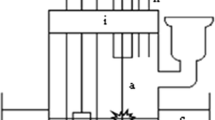Abstract
Effects of several electron acceptors (Fe3+, Cu2+, Cr(VI), and H2O2) on phenol degradation in anodic contact glow discharge electrolysis have been investigated. Results show that the electron acceptors have positive effects on phenol removal, with the sequence of Fe3+ > Cr(VI) > H2O2 > Cu2+. Under conditions of voltage 500 V and current 100 mA, 100 mg/L phenol can be removed with 10 min of discharge treatment in the presence of 1.0 mmol/L Fe3+, while without any additive only 35 % of phenol is removed in 30 min. The mechanism of the degradation enhancement was discussed based on the reactions taking place in the presence of the different additives.






Similar content being viewed by others
References
Malik MA, Ghaffar A, Malik SA (2001) Water purification by electrical discharges. Plasma Sour Sci Technol 10:82–91
Susanta KS, Rajeshwar S, Ashok KS (1998) A study on the origin of non-Faradaic behavior of anodic contact glow discharge electrolysis. J Electrochem Soc 145:2209–2213
Tezuka M, Iwasaki M (1997) Oxidative degradation of phenols by contact glow discharge electrolysis. Denki Kagaku 65:1057–1058
Wang L, Jiang XZ (2008) Plasma-Induced reduction of Chromium(VI) in an aqueous solution. Environ Sci Technol 42:8492–8497
Liu Y (2009) Simultaneous oxidation of phenol and reduction of Cr(VI) induced by contact glow discharge electrolysis. J Hazard Mater 168:992–996
Gao J, Wang X, Hu Z, Deng H, Hou J, Lu X, Kang J (2003) Plasma degradation of dyes in water with contact glow discharge electrolysis. Water Res 37:267–272
Gong JY, Wang J, Xie WJ, Cai WM (2008) Enhanced degradation of aqueous methyl orange by contact glow discharge electrolysis using Fe2+ as catalyst. J Appl Electrochem 38:1749–1755
Tomizawa S, Tezuka M (2007) Kinetics and mechanism of the organic degradation in aqueous solution irradiated with gaseous plasma. Plasma Chem Plasma Process 27:486–495
Liu YJ, Sun B, Wang L, Wang DG (2012) Characteristics of light emission and radicals formed by contact glow discharge electrolysis of an aqueous solution. Plasma Chem Plasma Process 32:359–368
Zhang J, Chen J, Li X (2009) Remove of phenolic compounds in water by low-temperature plasma: a review of current research. J Water Resour Prot 2:99–109
Wang L, Jiang XZ (2008) Unusual catalytic effects of iron salts on phenol degradation by glow discharge plasma in aqueous solution. J Hazard Mater 161:926–932
Shi XG, Dalal NS (1990) On the hydroxyl radical formation in the reaction between hydrogen peroxide and biologically generated chromium(V) species. Arch Biochem Biophys 277:342–350
Halpern J, Czapski G, Jortenr J, Stein G (1960) Mechanism of the oxidation and reduction of metal ions by hydrogen atoms. Nature 186:629–630
Chen R, Pignatello J (1997) Role of quinone intermediates as electron shuttles in Fenton and photoassisted Fenton oxidations of aromatic compounds. Environ Sci Technol 31:2399–2406
Grymonpre DR, Sharma AK, Finney WC, Locke BR (2001) The role of Fenton’s reaction in aqueous phase pulsed streamer corona reactors. Chem Eng J 82:189–207
Acknowledgments
This work was supported in part by the National Science Foundation of China (51008262, 11005014) and the Fundamental Research Funds for the Central Universities (2011JC016). The Natural Science Foundation of Fujian province, China (2010J05035), Outstanding Young University research personnel training plan foundation of Fujian Province, China (JK2011048) and the Science-Technology Foundation of Education Bureau of Fujian Province, China (JA10247) are also acknowledged.
Author information
Authors and Affiliations
Corresponding author
Rights and permissions
About this article
Cite this article
Wang, L., Liu, Y. Enhancement of Phenol Degradation by Electron Acceptors in Anodic Contact Glow Discharge Electrolysis. Plasma Chem Plasma Process 32, 715–722 (2012). https://doi.org/10.1007/s11090-012-9375-y
Received:
Accepted:
Published:
Issue Date:
DOI: https://doi.org/10.1007/s11090-012-9375-y




